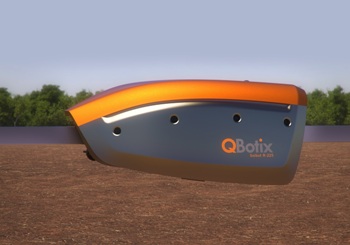Jul 10 2013
QBotix, which harnesses the power of robotics for the solar industry, today at Intersolar North America unveiled the SolBot R-225 and other enhancements for its Robotic Tracking System (RTS), a next generation system for optimizing the productivity of solar power plants.
 The SolBot R-225 can manage 340 kilowatts of solar panels, a 13 percent improvement over the SolBot R-200.
The SolBot R-225 can manage 340 kilowatts of solar panels, a 13 percent improvement over the SolBot R-200.
The SolBot R-225, a mobile robot for positioning solar panels and collecting data that is at the heart of RTS, builds upon the technical innovations of the SolBot R-200. The SolBot R-225 can manage 340 kilowatts of solar panels, a 13 percent improvement over the SolBot R-200. The SolBot R-225 is also smaller, lighter and requires fewer components than its predecessor, which increases reliability and allows the SolBot to operate in a wider variety of extreme environmental conditions. Additionally, the tracking rail for the SolBot R-225 consists of two preassembled pieces rather than multiple parts so it can be quickly snapped together on site.
"By reducing the number of moving parts in the SolBot, we have been able to boost the performance of the SolBot by a number of measures, which in turn will improve the performance of solar power plants. This is really a situation where less is more," said Wasiq Bokhari, CEO and founder of QBotix. "Solar is one of the fastest growing segments of the energy industry in nearly every market in the world. We're very proud to be able to help solar developers and power producers to lower the cost of solar energy."
To accommodate the broadest possible spectrum of customers, QBotix increased the flexibility and versatility of the communication network for the RTS so that it supports international and domestic frequencies and can coordinate and control the activities of multiple robots simultaneously.
QBotix debuted its technology in September 2012 and has enjoyed rapid commercial acceptance. In the first five months of 2013, RTS has been deployed at five commercial-scale power plants in California, Arizona, and Japan with a cumulative capacity of 200 kilowatts. More projects will be announced later in the year.
QBotix also announced that it has raised an additional $5 million from existing investors NEA, Firelake Capital and DFJ JAIC, bringing the total invested in the company to $12.5 million. The company also received a $1 million research grant from the Department of Energy's SunShot initiative.
RTS is an optimized dual-axis tracking system that employs rugged, intelligent, mobile robots to aim solar modules toward the sun and adjust their position throughout the day to maximize energy output. Trina Solar, Talesun and other solar module manufacturers and developers are collaborating on projects and initiatives in North America, Europe, and Asia.
With its robotic approach, RTS eliminates hundreds of stationary motors as well as substantial amounts of steel and concrete required in traditional solar power plants. The system comes pre-assembled, resulting in fast installation and commissioning, and works with all industry-standard solar panels, inverters, foundations, electrical and data systems. So-called balance of systems expenses now account for 68 percent of the cost of solar installations.
An RTS-based power plant with dual-axis tracking will typically generate up to 15 percent more electricity than a power plant built with conventional single-axis trackers, but cost similarly to build, giving QBotix customers dual-axis performance at single-axis pricing. An RTS-based power plant will generate up to 40 percent more electricity than a plant built with fixed-mount systems and improve project IRR's, NPV's and the levelized cost of electricity (LCOE) by up to 20 percent per kilowatt hour.
The intelligence and communication capabilities embedded in each autonomous robot also optimize power plant performance and provide detailed operational knowledge at an unprecedented level. Popular Science selected the system as one of top six innovations in its list of "Best of What's New" list for green technology for 2012.
About QBotix. Based in Menlo Park, CA, QBotix employs distributed robotics to significantly increase the economics and improve the capabilities of the solar industry. Please see website at www.qbotix.com.
Press release avilable from http://www.marketwire.com/